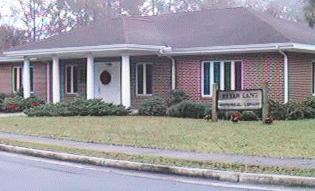 |
|
Woodbine History (incorporated city)
Woodbine Plantation was huge; in fact, it was one of the largest plantations in the area. The main crop grown there was rice. It is still located on the banks of the Satilla River. Nestled on the banks of the St. Illa, now known of as the Satilla River, the town of Woodbine has been around since the 1880s or 90s. The rice plantation was originally granted to Elijah Clarke by the state of Georgia in 1808. It was then sold Nathan and In 1893, the railroad took over transportation of rice from the vessels on the Satilla River. In fact, the railroad ran through on the actual plantation itself. Mr. Bedell, the owner at the time, allowed this under one condition: that the first community would be called Woodbine. It became the official name of the growing community when Woodbine was incorporated on August 17, 1908.
Text from nearby marker: "History tells of the
"Hobos" - wanderers, drifters For many, this was a way of life, learned from other professional train raiders or by first hand experience. They rode the trains, stopping now and again in a city or town to beg for their supper or look for day jobs or maybe something a bit longer, but always listening for the call of the whistle, that irresistible lure of the track, calling them back to the road.
Present day site of the railroad tracks that ran through Woodbine. They've been removed and a park with a boardwalk laid in their place. This runs between Oak Street West and Oak Street East. With the coming of the railroad, changes were made. Streets were laid, businesses were popping up, including a hotel and a post office (established in 1894). Mr. George W. Brandon was the first mayor. Travelers entering from the north had to cross the Satilla River. Owen's Ferry was in use until 1917 when a toll bridge was built. In 1941, Rawl's Pecan Co. was started. It was a rather successful business. It grew to cover Florida and South Carolina. You can still see a "Rawl's" when you enter Woodbine from the South on Highway 17 on your right. In the 1920's, the remaining plantation land was sold to Mr. Barnes. He then sold it to Mr. Van Drosky. When Mr. Drosky died, Mr. Barnes again took over. Shortly thereafter, Mr. Barnes disappeared. To this day, no one seems to know what became of him. In 1923, Woodbine became the County Seat. It used to
be in St. Marys, but at the time, Woodbine was easier to access then St.
Marys. In 1928, the Woodbine Courthouse was built. It remains the County
Seat today. In 1953, the Town of Woodbine was re-incorporated as the City of
Woodbine. In 1946 a hospital and clinic were built and in 1948 the Camden
County State Bank was chartered. Present day Woodbine pictured right. A visit to the old County Courthouse would be in order on any trip to Woodbine. It is a large, ornate building in the center of a square. In addition, the Bryan - Lang Library, also located at Courthouse Square, is the place to go for information on this area. It holds most of the old documents and information on the history of the County. By the way, it is only about a block away from the Courthouse.
|
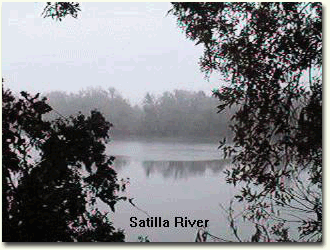 Once
owned by Mr. Bedell, Woodbine plantation
was originally named for a red flowering vine (trumpet honeysuckle) which
was plentiful in this area. There is very little left of this vine within
the city limits today - but this vine can still be found in the
unincorporated areas of the county.
Once
owned by Mr. Bedell, Woodbine plantation
was originally named for a red flowering vine (trumpet honeysuckle) which
was plentiful in this area. There is very little left of this vine within
the city limits today - but this vine can still be found in the
unincorporated areas of the county.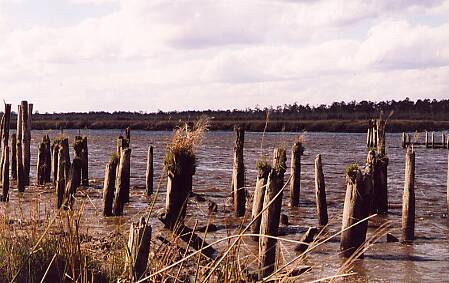 Joseph Bixby. Later, Nathan
Bixby's widow sold her share to Joseph and
Charles Drayton. John
Bailey bought Joseph Bixby's
share in 1835. It then remained in the Bailey family for
many years. It is said that during the Civil War, Northerners destroyed the
plantation house. In 1882, the overseer's house was destroyed by a tornado.
Despite the disasters and the many changing of hands, Woodbine continued to
be a successful plantation.
Joseph Bixby. Later, Nathan
Bixby's widow sold her share to Joseph and
Charles Drayton. John
Bailey bought Joseph Bixby's
share in 1835. It then remained in the Bailey family for
many years. It is said that during the Civil War, Northerners destroyed the
plantation house. In 1882, the overseer's house was destroyed by a tornado.
Despite the disasters and the many changing of hands, Woodbine continued to
be a successful plantation.
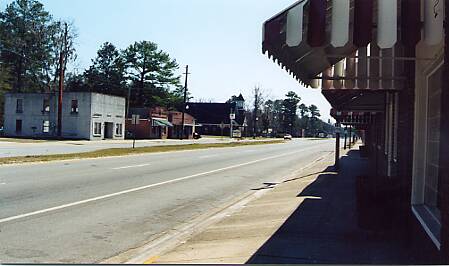 Campbell
Johnston died in a RR accident. As no one knew how to
contact his family, his remains were interred near the tracks in Woodbine.
This is the only known grave that lies within the Woodbine City Limits. I
find it curious that while a nearby marker says that he was a "hobo" -
apparently folks knew him well enough to know his exact birth date. I have
heard an alternate story that he was a railroad worker.
Photo--Downtown Woodbine 2001
Campbell
Johnston died in a RR accident. As no one knew how to
contact his family, his remains were interred near the tracks in Woodbine.
This is the only known grave that lies within the Woodbine City Limits. I
find it curious that while a nearby marker says that he was a "hobo" -
apparently folks knew him well enough to know his exact birth date. I have
heard an alternate story that he was a railroad worker.
Photo--Downtown Woodbine 2001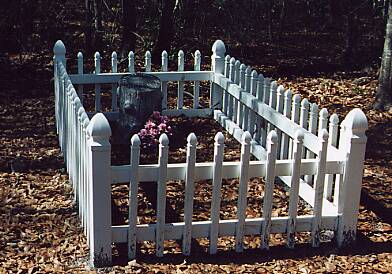 and vagabonds. People who made their home in the boxcars of the 19th and
early 20th century railroads.
and vagabonds. People who made their home in the boxcars of the 19th and
early 20th century railroads.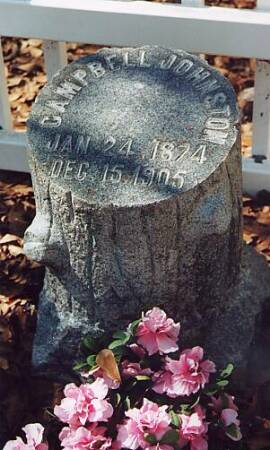 This
man, Campbell, was one such hobo. Local legend holds that
Mr. Johnston fell from the train one
fateful night and was killed at this site. Local officials buried Mr.
Johnston and the stone marking his grave was donated by the
Woodmen Of the World."
This
man, Campbell, was one such hobo. Local legend holds that
Mr. Johnston fell from the train one
fateful night and was killed at this site. Local officials buried Mr.
Johnston and the stone marking his grave was donated by the
Woodmen Of the World."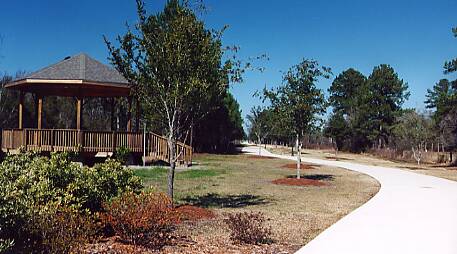
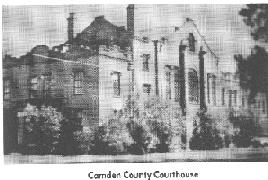 Today
Woodbine is still a small town. It is a quiet place to live away from the
noise and traffic of St. Marys or Kingsland. There are many old houses and
other types of buildings still in use in Woodbine. In fact, my mother-in-law
recently began renovating the old Proctor House.
Today
Woodbine is still a small town. It is a quiet place to live away from the
noise and traffic of St. Marys or Kingsland. There are many old houses and
other types of buildings still in use in Woodbine. In fact, my mother-in-law
recently began renovating the old Proctor House.